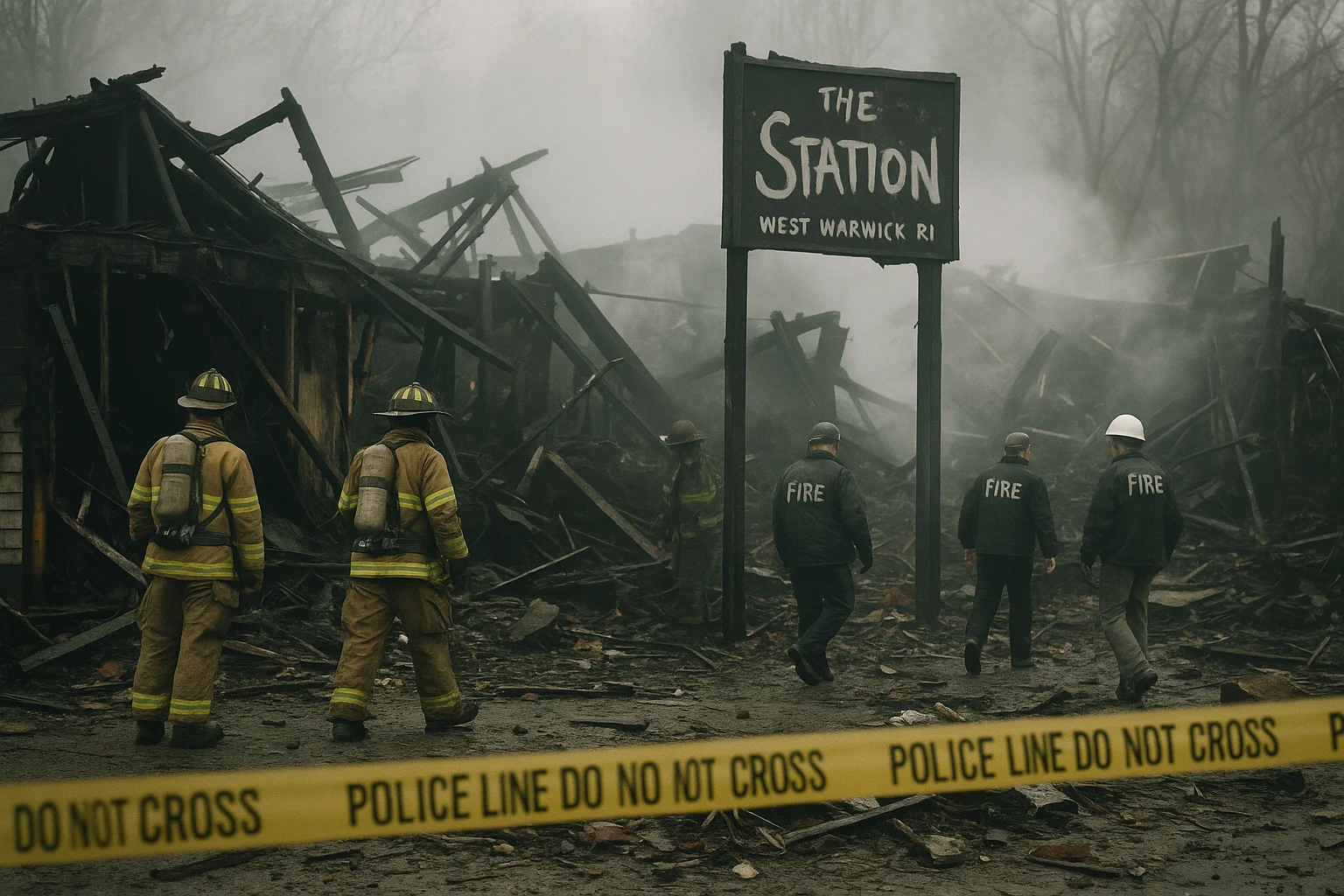
The Station Nightclub Fire
by: The Calamity Calendar Team
February 20, 2003
A Night Meant for Music
The air in West Warwick, Rhode Island, was crisp on the night of February 20, 2003. Inside The Station nightclub, however, warmth emanated from the crowd gathered to see the rock band Great White. The venue was alive with the throb of anticipation, music reverberating from wall to wall. People packed shoulder to shoulder, vying for standing room, unaware that the night’s performance would soon spiral into one of the deadliest nightclub fires in U.S. history.
The Station, a once-bustling restaurant turned club, was not equipped for such gatherings. This night, the capacity limit of 404 was ignored, with the club jam-packed beyond its limits, hosting over 440 patrons eager for live music. The stage was set, not just for a show, but tragically for disaster.
Lighting the Fuse
As the clock ticked past 11 PM, Great White climbed the stage, kicking off their set with fervor. The band had a ritual—a striking visual—a burst of pyrotechnics to ignite the crowd along with their performance. Four small devices, known as gerbs, fired streams of sparks, a spectacular sight designed to electrify the atmosphere. However, what followed was not mere entertainment. The sparks caught the soundproofing foam lining the stage, a mistake hidden in darkness and oversight.
In seconds, tongues of fire licked the ceiling, rapidly consuming the highly flammable polyurethane foam. Smoke thickened the air almost instantly, and a faint awareness swept the room. What began as a raucous cheer shifted to a collective murmur of confusion, then fear, before turning into a surge of panic.
Thanks for subscribing!
Chaos Unfurls
At 11:10 PM, only moments since the fire began, chaos had engulfed the club. Flames spread at a speed that defied belief, turning the promise of a night out into utter horror. The thick smoke choked visibility, while the pungent fumes made every breath laborious. Many in the crowd initially thought the fire was part of the show, a misjudgment that cost precious seconds. Once realization struck, the fight for survival became frantic.
The main entrance, designed for casual arrivals, now transformed into a choke point—people pushed and clawed their way through, and a human bottleneck formed. Others sought side exits, grappling in the dim light, directed only by instinct and desperation. Less than six minutes after it erupted, the fire had devoured the building, leaving behind smolders and ash.
The Unthinkable Toll
The inferno extinguished dreams and futures in the blink of an eye. When the flames finally surrendered, 100 lives were lost, and 230 more were severely injured. Those who escaped unharmed carried invisible scars. As daylight broke, exposing the charred skeleton of The Station, the reality of the devastation settled over the community like the ash that blanketed the site.
The fire’s aftermath extended far beyond physical damage. Family narratives were rewritten through grief; local and national infrastructures were shaken by the scope of the disaster. An unyielding quest for accountability began.
Aftermath and Accountability
Emergency crews arrived swiftly, but the swiftness of the disaster had already left its indelible mark. The following weeks saw a flurry of investigative efforts to determine exactly what went wrong. Attention turned toward the critical missteps: the overcrowded venue, improper fireproofing, and the legal and moral failings surrounding safety ordinances.
In the face of such disaster, reform was imperative. Rhode Island took bold steps, rewriting fire safety regulations comprehensively for the first time in years. Similar venues across the country faced heightened scrutiny. Sprinkler systems, proper exits, and strict pyrotechnic protocols became non-negotiable mandates.
A Community Reimagined
Legal consequences ensued, targeting those deemed responsible. The owners of The Station nightclub faced criminal charges, as did members of the band’s entourage. Settlements were reached, but for those affected, no figure could quantify the loss endured.
Yet from tragedy, seeds of resilience and remembrance took root. A community gravitated towards healing, honoring those lost. Out of the ashes rose the Station Fire Memorial Park, a space where memory and solace coexist. It stands as a perpetual reminder of lives shortened, love enduring, and the million "what-ifs" that haunted those who survived.
The Lessons We Carry
Today, the echo of the Station nightclub fire remains a poignant testimony to the inherent responsibility of safety and vigilance. It’s a chapter forever engrained in fire safety reform and a galvanizing force behind ensuring venues across the nation are sanctuaries rather than sites of peril.
In acknowledging the complexities and failings that surrounded the event, we honor a somber doctrine: no concert is worth a life, and no oversight is permissible when lives hang in the balance. This narrative, set to the discordant backdrop of a night intended for joy, offers a lesson learned through unimaginable cost—a lesson we cannot forget.
Stay in the Loop!
Become a Calamity Insider and get exclusive Calamity Calendar updates delivered straight to your inbox.
Thanks! You're now subscribed.